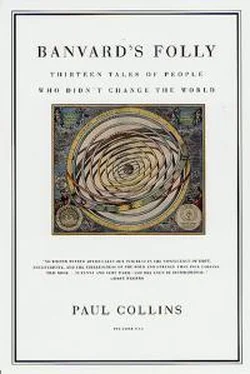Pleasonton, in all likelihood, scarcely saw a penny off his patent.
When that raw medical recruit saw the blue and red panes at the American Health College years later, he was seeing a knockoff of a knockoff of Pleasonton--for as hapless as Pleasonton was at defending his patent, others were all too ready to cash in on blue light. At the height of the frenzy in 1877, Seth Pancoast, a rather colorful figure among medical writers of the time, quickly produced his own guide to light therapy, Blue and Red Light; or, Light and Its Rays as Medicine (1877). Like Pleasonton's book, it was published in Philadelphia. Pancoast expanded on colored light treatments--"the source of all the physical and vital forces in nature"-by including some uses for red light; he even one-upped Pleasonton by printing his book in blue ink with a red border.
Pancoast was not a man to let a few failed experiments get in the way of his
belief in colored glass:
Facts are facts; they must and will in the end stand in spite of their defects or faults in the eyes of scientists. Facts are stubborn and do not always yield to "authorities." ... The "failure" of the most accepted experiments by the most accepted experts, proves absolutely nothing beyond the proof of their failure.
Indeed, for Pancoast the efficacy of light became an article of faith. While Pleasonton made some religious musings in his book, in Pancoast the spiritual element of heavenly light became much more pronounced; by 1883, his medical text had morphed into the theosophical hodgepodge of The Kabbala: Or, The True Science of Light. Nor was he the only writer to make this connection, for just a year after Pancoast's Blue and Red Light, Edwin Babbitt published the quasi-mystical Principles of Light and Color (1878).
Scientific publications, then as now, rolled their eyes at the way the public fervently medicated itself with a hash of quackery, theological hoodoo, and half-understood medical research-following anything, in other words, except the advice of a trained physician. One issue of the journal Railway Surgeon took this potshot at women who dabbled in medical fads: THE SCIENTIFIC HOUSEWIFE
Give me a spoon of oleo, ma, And the sodium alkali, For I'm going to make a pie, mamma, I'm going to make a pie; For John will be hungry and tired, ma, And his tissues will decompose-So give me a gramme of phosphate, And the carbon and cellulose.
Now, give me a chunk of casein, ma, To shorten the thermic fat; And hand me the oxygen bottle, ma, And look at the thermostat. ...
And so forth. Others were less inclined to merely laugh at such trends--and as the blue glass mania reached its height, Scientific American decided that it had had enough.
When Alfred Ely Beach and his writers decided to shatter the blue glass fad, it was through an almost unprecedented multipart series of articles in its pages, beginning with the three-part "The Blue Glass Deception" on February 24, 1877. Scientific American was a weekly magazine back then, and each week for much of 1877 its readers were treated to public trouncings of the research of A. J. Pleasonton, sometimes two or three times in the same issue.
The magazine immediately hit Pleasonton with the most damning fact of all: standing under blue glass exposed you to less blue light than just standing out in the sun, or under clear glass. A piece of common cobalt blue glass merely diminishes all the rays across the visible spectrum; blue and violet are diminished less than the others, but they are diminished. "Prior to these splendid original discoveries of our contemporary," the magazine sneered on February 24, "we ignorantly believed that blue glass only partially sifted out the orange and yellow rays from the spectrum." And given that what Pleasonton had used was only one pane of blue glass to seven panes of clear glass, the net composition of his "cure" was this: very slightly shaded ordinary sunlight.
The drumbeat continued the next week with another installment, this time attacking the supposed cures caused by blue light. Pleasonton's sources of experimental information on electricity and blue light had long been disproved, it pointed out. And as for Dr. Ponza's lunatics, the explanation had less to do with blue glass than with the tendency for people to calm down
when placed in any kind of shaded or darkened room.
What curative power blue glass had was, the magazine concluded, derived from that most universal of all panaceas: the placebo effect.
The cures produced are ascribable to two causes: first, to the healthy influence of the sun bath, and secondly, to the very powerful influence of the patient's imagination. There are abundant cases known where imagination has so powerfully affected the body as to cause death.
Experiments upon criminals have shown that in one instance, where a person was placed in a bed which, he was informed, had just been vacated by a cholera patient (but which had not), he exhibited all the symptoms of the disease.
Another person is reported to have shown all the signs of collapse from loss of blood, from the supposition that he was bleeding to death.
There is something to this. Battlefield medics during the Civil War had already discovered that, at least temporarily, they could "cure" pain and shell shock through what amounted to sleight of hand. As Dr. William Hammond describes in his bizarrely compelling 1883 volume A Treatise on Insanity in its Medical Relations, the Union colonel Charles May used just such a trick to cure one deranged officer "of the belief that he was inhabited by chicken bones."
But General Pleasonton was no mere colonel, and he certainly was not a charlatan. He struck back within days with angry letters to newspapers. He did not have a particularly good rebuttal to Scientific American's point about the nature of blue glass, but he was indignant that the article was titled "The Blue Glass Deception," for the word "deception" implied that he was some sort of scoundrel. When the third part of the series ran on March 10, the editors offered the backhanded apology that "we believe that General Pleasonton deceives both himself and the public." And as for any further offense they caused, the magazine didn't much care: "Our long experience in dealing with circle squarers, perpetual motionists, Keely motor people, and now blue glass adherents, besides all the other deceptions rife in the mechanical and scientific world, enables us to bear such animadversion with unruffled equanimity."
And that, the magazine said, was all it had to say on the subject. Only it wasn't, really, because as the fad continued to grow throughout 1877, the editors kept inserting new digs at Pleasonton into their pages. In the March 17 issue, this sly poke was inserted as filler at the bottom of one page:
"Blue glass will cure a Spitz dog of hydrophobia. Pound it up fine, and mix it with his food." When another medical fad was reported in France the next week--this being the use of Metallotherapy, or the application of cylinders of various metals to cure ailments--the magazine suggested that it might be a good replacement therapy for "when the blue glass believers become tired of their hobby."
Nor did it limit itself to roasting blue glass proponents. A lively trade had started up in urban legends about the dangers of blue glass, as this passage from the New York Evening Post shows:
A gentleman in Brooklyn suffering from weakness of sight was recently led by the advice of well meaning friends to use spectacles of blue glass, such as certain opticians are selling just now. The result was that his eyes, already too weak to be used much in ordinary circumstances, were exposed to a terrible glare and heat, which in less than a week entirely destroyed the eyesight of the sufferer. He is now totally blind ... the dupe of blue glass enthusiasts.
Читать дальше











